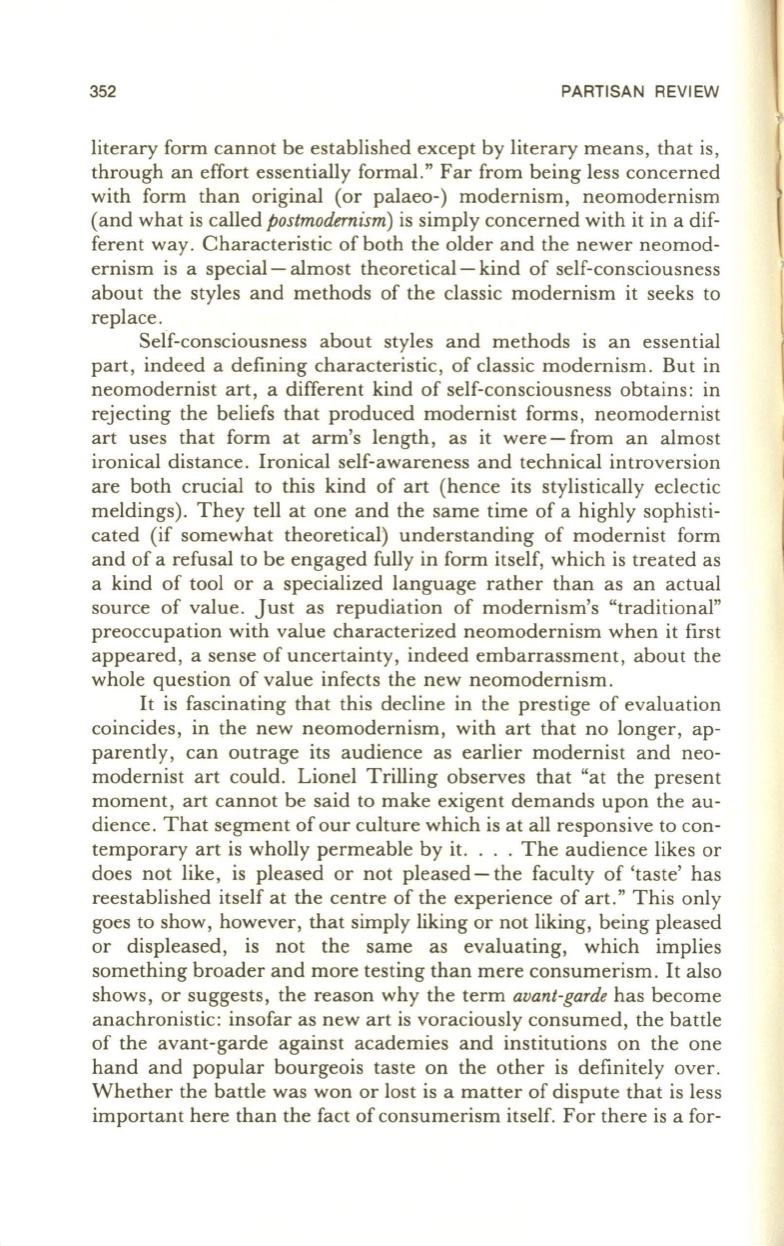
352
PARTISAN REVIEW
literary form cannot be established except by literary means, that is,
through an effort essentially formal." Far from being less concerned
with form than original (or palaeo-) modernism, neomodernism
(and what is
calledpostmodernism)
is simply concerned with it in a dif–
ferent way. Characteristic of both the older and the newer neomod–
ernism is a special- almost theoretical- kind of self-consciousness
about the styles and methods of the classic modernism it seeks to
replace.
Self-consciousness about styles and methods is an essential
part, indeed a defining characteristic, of classic modernism. But in
neomodernist art, a different kind of self-consciousness obtains: in
rejecting the beliefs that produced modernist forms, neomodernist
art uses that form at arm's length, as it were - from an almost
ironical distance. Ironical self-awareness and technical introversion
are both crucial to this kind of art (hence its stylistically eclectic
meldings). They tell at one and the same time of a highly sophisti–
cated (if somewhat theoretical) understanding of modernist form
and of a refusal to be engaged fully in form itself, which is treated as
a kind of tool or a specialized language rather than as an actual
source of value. Just as repudiation of modernism's "traditional"
preoccupation with value characterized neomodernism when it first
appeared, a sense of uncertainty, indeed embarrassment, about the
whole question of value infects the new neomodernism.
It is fascinating that this decline in the prestige of evaluation
coincides, in the new neomodernism, with art that no longer, ap–
parently, can outrage its audience as earlier modernist and neo–
modernist art could. Lionel Trilling observes that "at the present
moment, art cannot be said to make exigent demands upon the au–
dience. That segment of our culture which is at all responsive to con–
temporary art is wholly permeable by it. ... The audience likes or
does not like, is pleased or not pleased - the faculty of 'taste' has
reestablished itself at the centre of the experience of art." This only
goes to show, however, that simply liking or not liking, being pleased
or displeased, is not the same as evaluating, which implies
something broader and more testing than mere consumerism.
It
also
shows, or suggests, the reason why the term
avant-garde
has become
anachronistic: insofar as new art is voraciously consumed, the battle
of the avant-garde against academies and institutions on the one
hand and popular bourgeois taste on the other is definitely over.
Whether the battle was won or lost is a matter of dispute that is less
important here than the fact of consumerism itself. For there is a for-


